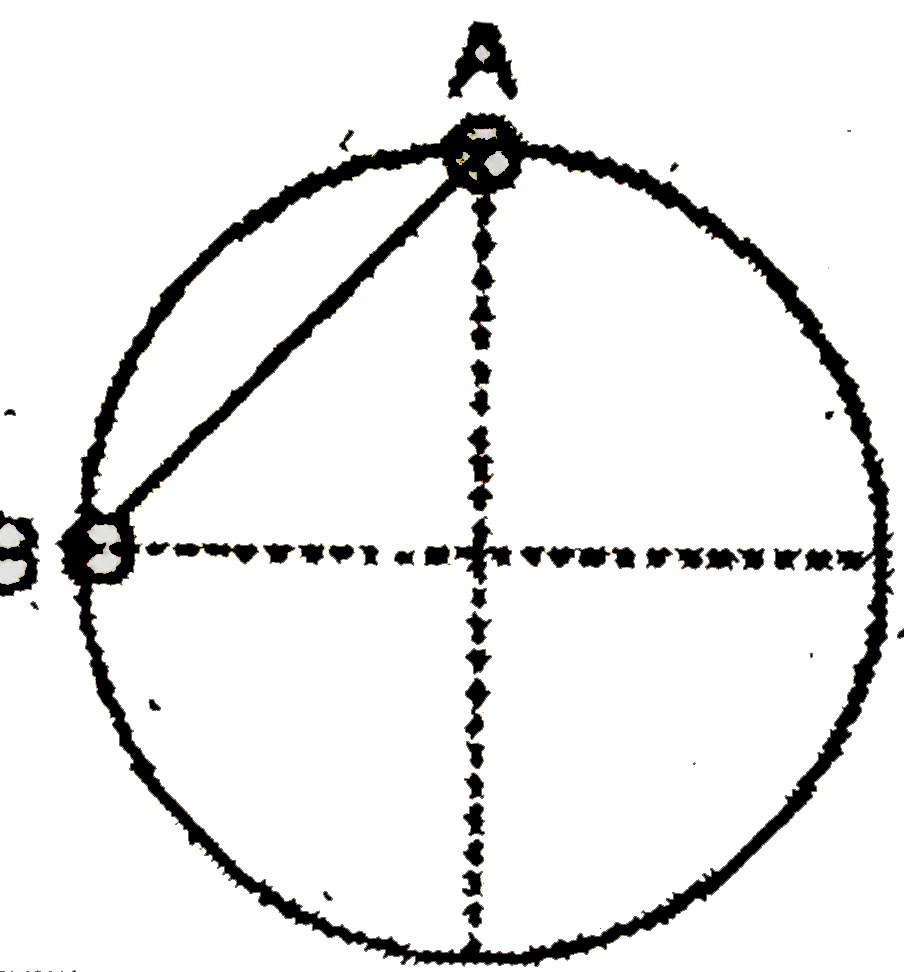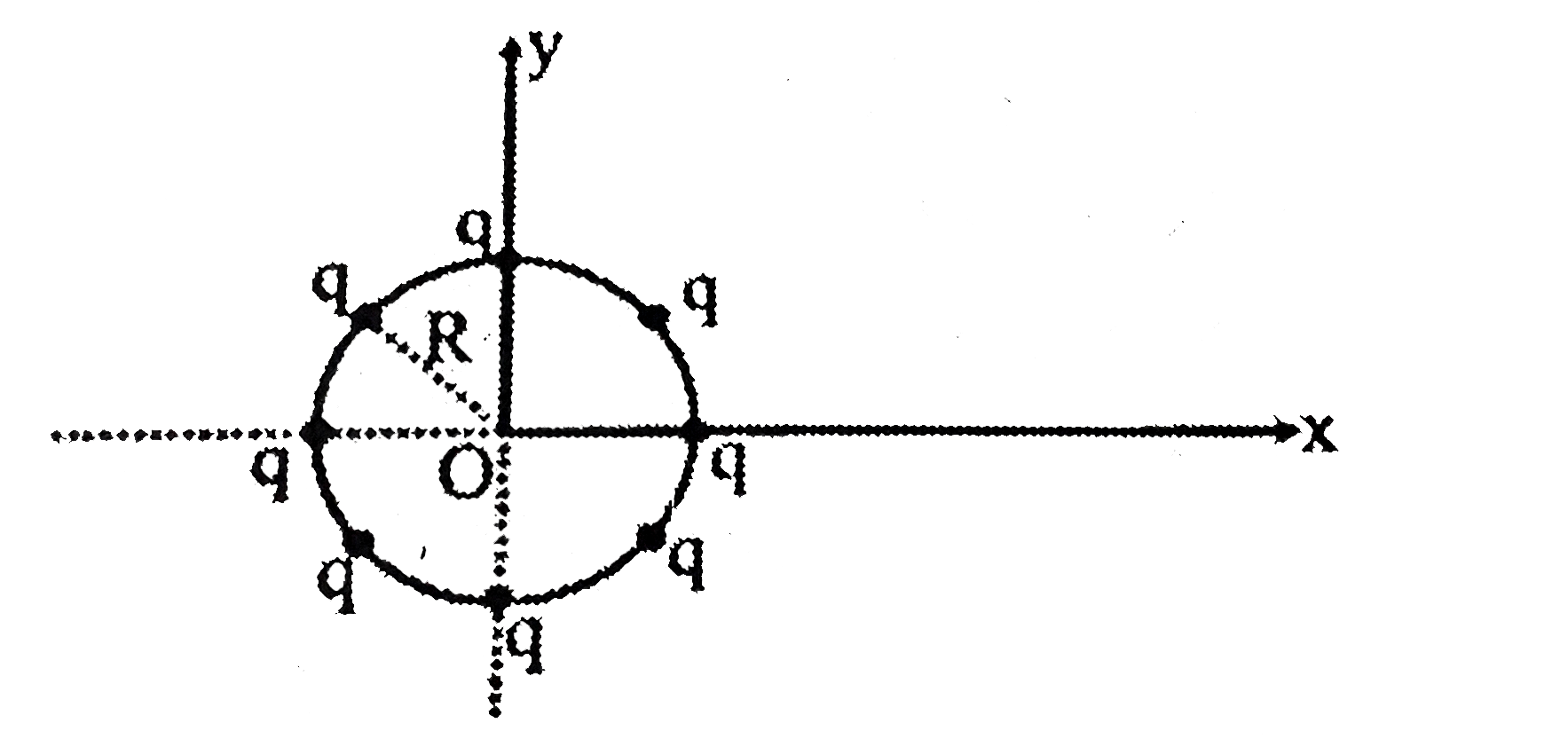The diagram show a small bead of mass m carrying charge q. The bead can freely move on the smooth fixed ring placed on a smooth horizontal plane . In the same pane a charge +Q has also been fixed as shown. The potential at the point P due to +Q is V . The velocity which the bead should projected from the point P so that it can complete a circle should be greater than .

√6qVm
4√qVm
√3qVm
√7qV2m
The correct Answer is:A
If we send the bead diametrically opposite, it will complete full circle as resultant of repulsive force between the charges and normal reaction between the ring and bead will provide force in tangential direction of ring.
Hence at point 2,v2=0.
Given 14πε0Q4a=V
or 14πε0Qa=4V
Let velocity given at 1 be v1, then
12mv21+14πε0Qq4a=0+14πε0Qqa
or 12m21=3Vq+qV=q−4V
or 12m21=3Vq or V1=√6Vqm

Topper's Solved these Questions
- MISCELLANEOUS VOLUME 3BOOK - CENGAGE PHYSICSCHAPTER - MISCELLANEOUS VOLUME 3EXERCISE - Multiple Correct Answer type
109 Videos
- MISCELLANEOUS VOLUME 3BOOK - CENGAGE PHYSICSCHAPTER - MISCELLANEOUS VOLUME 3EXERCISE - Assertion and Reason Type
8 Videos
- MECHANICAL PROPERTIES OF SOLIDSBOOK - CENGAGE PHYSICSCHAPTER - MECHANICAL PROPERTIES OF SOLIDSEXERCISE - Question Bank
4 Videos
- MISCELLANEOUS VOLUME 5BOOK - CENGAGE PHYSICSCHAPTER - MISCELLANEOUS VOLUME 5EXERCISE - Integer
12 Videos
Similar Questions
A charge "Q" of mass "m" is at rest on a smooth horizontal plane.Another identical particle is projected with a velocity v towards it from long distance then
View SolutionA particle of mass m carrying a charge −q1 starts moving around a fixed charge +q2 along a circulare path of radius r. Find the time period of revolution T of charge −q1.
View Solution
Knowledge Check
A particle of charge q is projected from point P with velocity v as shown. Choose the correct statement from the following.
 AMagnetic field at P is μ0i4πr[2+√2]⊙BThe magnetic field at P is μ0i/2πr.CThe particle initially accelerated towards wire A.DThe particle initially accelerated towards wire B.
AMagnetic field at P is μ0i4πr[2+√2]⊙BThe magnetic field at P is μ0i/2πr.CThe particle initially accelerated towards wire A.DThe particle initially accelerated towards wire B.A very long straight wire carries a current I. At the instant when a charge +Q at point P has velocity →V, as shown, the force on the charge is
 AOpposite to OXBAlong OXCOpposite to OYDAlong OY
AOpposite to OXBAlong OXCOpposite to OYDAlong OYThe minimum velocity v with which charge q should be projected so that it manages to reach the centre of the ring starting from the position shown in figure is
 Av=√kQqmR(2−√2)Bv=√kQq2mR(2−√2)Cv=√kQqmRDv=√kQq√2mR(1−√2)
Av=√kQqmR(2−√2)Bv=√kQq2mR(2−√2)Cv=√kQqmRDv=√kQq√2mR(1−√2)
A bead C can move freely on a horizontal rod. The bead is connected by blocks B and D by a string as shown in the figure. IF the velocity of B is v. find the velocity of block D.

View SolutionTwo beads A & B of equal mass m are connected by a light inextensible to move on a connected to move on a frictionless ring in vertical plane. The beads are released from rest as shown. The tension in the cord just after the release is:

View SolutionA particle of mass m carrying charge q is projected with velocity v from point P toward aninfinite line of charge from a distance a . Its speed reduces to zero momentarily at point Q, which is at a distance a/2 from the line of charge. If another particle with mass m and charge −q is projected with the same velosity v from P toward the line of charge, what will be its speed at Q ?
View SolutionEight charges each of value q each are placed on a ring of radius R placed in x-y plane with origin at centre -q charge having mass m is projected from z=∞ towards the centre of the ring with velocity v. The velocity of -q when it reaches the centre of ring is (neglect gravity)-

View SolutionEight charges each of value q each are placed on a ring of radius R placed in x-y plane with origin at centre -q charge having mass m is projected from z=∞ towards the centre of the ring with velocity v. The velocity of -q when it reaches the centre of ring is (neglect gravity)-

View Solution
